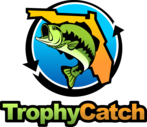 TrophyCatch Season 5 ended September 30. Keep a close eye on our Facebook page for announcements regarding the upcoming Hall of Fame ceremony and the Phoenix Boats TrophyCatch bass boat finalists and drawing! We will also have some very exciting prizing news for Season 6!
|
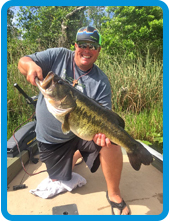
Despite this past quarter including the "dog days" of summer, TrophyCatch participants helped prove that any time of year is a great time to go fishing in Florida, the Bass Fishing Capital of the World! Adam Evans caught and released this 13 lbs 2 oz monster just before the quarter's start on June 27 in
Rodman Reservoir. The fish was 28 inches long with a hefty 19 inch
girth. This would be a state record in more than half the country, and
was the 14th Hall of Fame fish weighing 13+ lbs for Season 5.
|
ICAST is the fishing industry's biggest annual trade show, and TrophyCatch was there to tell anglers about the program and brag (just a little) about the great bass fishing here in Florida! (Left photo) The show also provided the opportunity to interact with some of the many partners that have helped to make TrophyCatch both fun and rewarding. On display was the Phoenix Boats TrophyCatch bass boat and some incredibly realistic replica mounts from New Wave Taxidermy. Both also helped showcase the program at the American Fisheries Society annual meeting in Tampa, where research findings based on TrophyCatch data submitted by participants was presented. (Right photo)
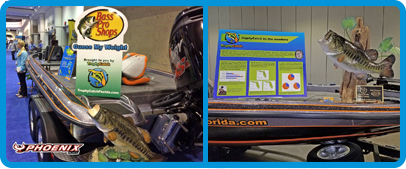 |
Several TrophyCatch anglers were featured in the September issue of Florida Sportsman magazine
in a great article by David McGrath! The article focused on
TrophyCatch submissions from smaller waters, proving that even a little
pond can hold big fish -- in Florida the Bass Fishing Capital
of the World! Anglers mentioned included Dominic Montalto, Jean Wilson (who has submitted some amazing kayak catches),
Zach McGowen, and Arthur “AJ” Jackson.
|
|
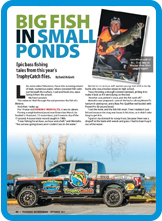 |
 Size: The state record is 0.83 pounds, but most catches of this diminutive sportfish will average closer to a quarter pound. The Big Catch minimum qualifying sizes are 0.5 pounds or 7 inches for adults, and 0.4 lbs or 5 inches for youth (BigCatchFlorida.com).
Identification and similar species: The spotted sunfish is relatively nondescript. As the name suggests,
however, its most characteristic feature is the distinct, even rows of small
spots along the body. These dots are usually dark, but may be red. In overall
coloration, the fish ranges from olive to brown. In general form, this small sunfish
also appears somewhat “chunkier” or plumper than other sunfishes.
Angling qualities: The spotted sunfish is often caught
incidentally by anglers targeting its larger relatives, the bluegill and redear
sunfish. Called a “stumpknocker” because of its affinity for submerged timber,
this fish is sometimes deliberately sought after by north Florida stream
anglers. Don't let this fish's small size fool you—they are very aggressive in defending their bed during the spawning season. The
spotted sunfish will take most small lures and baits and puts up a good fight. Its small size makes it ideal for
ultralight tackle (see Issue 10). A flyrod also works well, and this fish is particularly
susceptible to tiny nymphs. Excellent baits include grass shrimp, live worms,
and crickets—standard bream fare. While quite edible, most anglers will likely
deem only larger representatives of this species to be big enough for the frying pan.
Where to catch them: Spotted sunfish are found throughout Florida, but are deliberately targeted most by stream anglers in the northern part of our state. Some specific sites to try include the Choctawhatchee River, Holmes Creek and Lake Panasoffkee.
Illustration by Duane Raver, Jr.
|
 Size: 3,779 acres.
Location: Near Dundee, Florida in eastern Polk County.
Description: Lake Pierce is part of the headwaters to the Kissimmee Chain of Lakes (upper headwaters to Lake Okeechobee and the Everglades). This lake provides surface flow to Lake Hatchineha, via Catfish Creek. Lake Pierce has historically been a popular fishing destination for local residents and has the potential to sustain large amounts of angler effort, given its large surface area. In 2013, Lake Pierce stakeholders approached FWC with concerns regarding the lake’s largemouth bass fishery. In response to stakeholder concerns, the Division of Freshwater Fisheries Management developed a management plan for Lake Pierce which incorporated resource user input about the sport fishery. The management plan focused on specific management actions to improve the largemouth bass fishery.
|
 One of these management
actions, stocking semi-advanced fingerling (about 2 inches long) largemouth bass,
was considered a good way to supplement low recruitment of new fish into the population and improve
angler catch rates over the long term. Evidence suggests that high
stocking rates of semi-advanced bass fingerlings on some Florida waters (e.g. Lakes Talquin and Wauburg) over consecutive years can offset low largemouth bass recruitment. A pilot study was conducted on
Lake Pierce in spring 2014 with the stocking of 160,000 semi-advanced
fingerling fish. Initial results showed approximately 5% contribution of
the 2014 stocking to the 1 year bass age class in
2015. A larger multi-year stocking program was initiated in spring 2016
with the proposed stocking of about 500,000 semi-advanced fingerlings
annually through 2018. The objective is to stock semi-advanced
fingerling largemouth bass in Lake Pierce over multiple years at a size
capable of consuming newly spawned threadfin shad in order to supplement
low recruitment and increase angler catches over time. Largemouth
bass populations have been surveyed annually since 2014 and overall
catch rates have increased. Size structure analyses indicate the lake’s
bass population has remained stable since 2014 and remains healthy.
|
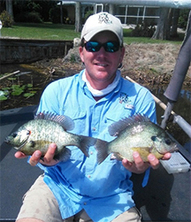 Local anglers usually target largemouth bass during the spring months by
“flipping” Texas-rigged soft plastic crawfish and stick style baits in
and around the heavily vegetated shorelines that Lake Pierce offers.
During the “dog days” of summer, the chances of catching fish are
enhanced by the presence of five natural brush pile fish attractors
strategically placed around the lake, usually in deep water. Anglers
may also locate bass by fishing the edges around the brush piles with
shad-colored crankbaits and bucktail jigs. Don’t be afraid to bump your
faster moving baits off the brush piles to produce that reaction strike
largemouth bass are so well-known for. Anglers can also slowly
drag Texas-rigged soft plastic worms and grass jigs with “chunks”
through the thickest areas of the piles to get those stubborn fish to
bite. For more information on the location of fish attractors, visit the FWC's Interactive Fish Attractor Map found on our website.
Recent fish surveys on Lake Pierce may have also uncovered a “sleeper”
bluegill and redear sunfish fishery. These sunfish can be targeted near
full moon phases in shallow, vegetated areas where they typically
congregate to spawn and can also be caught by fishing on the bottom with
live crickets or wigglers. Use small hooks and light line when
targeting these species and be ready for a fun fight when you hook one!
Tight lines!
There are two
public boat ramps on Lake Pierce. For more information on how to access
Lake Pierce and the rest of the Kissimmee Chain of Lakes, please visit
our Florida Boat Ramp Finder.
Continued
monitoring of the Lake Pierce largemouth bass population will proceed
until 2020 and it is hoped that another fishery success story like those
from previous studies on lakes in the Panhandle (Lake Talquin) and
North Central (Lake Wauburg) Florida will make fishing on Lake Pierce even better.
|
 |
In Florida, trolling is one of the standard bluewater
techniques for offshore fishing. Many northern anglers also employ
trolling in lakes routinely. So why isn’t this method of fishing
more popular in Florida’s fresh waters? First,
it's an illegal method for tournaments—which should tell you something about how effective trolling can be! Also, our fresh waters simply aren’t deep enough for trolling techniques like downriggers or diving planes. Finally, the abundant vegetation in Florida lakes and ponds can interfere with traditional
trolling methods. However, under the right conditions and with proper selection of lure or bait, trolling can be practical here. Whether you’re on a
first visit to a new lake or returning to your favorite pond for the hundredth
time, trolling is an effective way to find and catch fish.
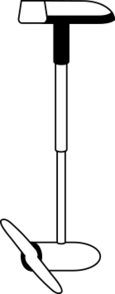 Trolling motors — They’re actually called “trolling” motors, so why not use
them as such? The heart of a trolling system is indeed going to be the motor.
Anglers today enjoy a broad selection of electric motors that are more convenient
and more powerful than their predecessors, with a number of available options
to make trolling that much simpler. Make sure that you choose a motor adequate
to the size and weight of the boat; a careful choice will allow you to maintain
a steady troll in the face of diverting winds or currents. Both bow and
transom mount styles are available. A
trolling motor will last for years if properly cared for. Remove the prop and
check for fishing line after each trip; if line works past the seals into the
electric motor itself it can ruin it. When the prop is removed, hit any exposed lower
unit bolts with a shot of WD-40 to prevent corrosion during storage. When on
the water, remember to raise the trolling motor before jetting off to the next
spot, because the forced turning of the prop can burn out the electric motor.
|
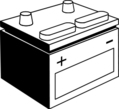 Batteries — A few
thoughts on batteries are in order . . . first of all, you should have a
dedicated trolling motor battery. Hooking those alligator clips up to
your
starting battery might leave you furiously hand-cranking that 90 HP
outboard as
the sun sets with you still ten miles from the ramp. Only buy a deep
cycle
battery engineered to handle a steady drain (the reason starting
batteries
don’t perform well for trolling is because they are designed to provide
only
short bursts of power). Modern technology has created a number of
advancements in the type and efficiency of trolling batteries, but pay
attention to the manufacturer's instructions for charging and depleting
your battery in order to maximize its longevity.
|
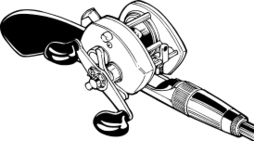 Trolling gear — Most spinning or casting outfits are suitable for trolling
(even flyfishing gear). For most trolling, anglers will want to keep their
hands on the rod rather than place it in a rod holder. Longer rods have the
advantage for more precisely controlling the path of bait or lure as you troll
past an enticing looking stump or patch of lily pads. They also provide for
more distance between baits when running two lines off one boat. If you’re a
light tackle angler you might wish to switch up a couple pounds in line test,
as the forward momentum of the boat coupled with a fish’s strike may lead to
more breakoffs than you are accustomed to.
A depth finder is a tremendous aid in trolling. It will help
you monitor the bottom to ensure that you are maintaining the ideal depth for
your lure of choice. It will also reveal bottom structure (and even fish) so
that you can prepare for a couple of bumps (or a strike) on the line. Depending
on the lure or bait, it will also give you enough warning to lift your rod tip
and raise your bait clear of an obstruction. Some trolling motors even come
with depth finders built in.
A
speedometer can also be very helpful to track your actual trolling speed
(relative to the water itself) when wind and current are either speeding or
slowing your boat. It also allows you to maintain the best speed for a given
lure (which of course you tested beside the boat before beginning your troll).
|
 Trolling for bass — Bass are one of the easiest Florida fish to troll for. There
are already a variety of weedless lures available, which help offset one of the
primary hurdles to trolling in Florida’s fresh waters. A Carolina-rigged
plastic worm is possibly the most weedless trolling lure there is, able to bump
and slither its way over and around a broad array of obstacles. When trolling
with plastic worms, hold the rod tip forward of your sitting position; when the
familiar tap-tap-tap of a strike occurs, you can instantly drop the rod tip
back and give the fish some slack as you stop the motor and prepare to set the
hook. Other weedless bass lures to try include spinnerbaits, Johnson Silver
Minnows, curly-tail grubs, and weedless spinners like a Snagless Sally (be sure to use ball bearing
swivels with the latter).
In more
open waters, a shallow-running Rapala or Rebel minnow is hard to beat (though
you can use any of the lures listed above); Rat-L-Traps are another great
choice. Speed-trolling these lures as fast as they will go without rolling will
sometimes produce fish when other tactics fail. For deeper locales, use
crankbaits to get down to the fish. Choose crankbaits based on the desired
depth, but keep in mind that a trolled lure will run deeper than its rated
running depth (which is usually based on cast-and-retrieve). For any lure
except plastic worms, keep your rod tip back instead of forward and set the
hook instantly when you feel a strike.
Trolling
with bait can be very effective. Shiners and shad are the temptations of
choice. Always hook the bait through the lips. Troll slowly enough so that the
minnow can swim naturally and isn’t being dragged through the water. If a bait
begins to roll on the surface, you’re going too fast. In weedier waters, use a
hook with a weedguard. If you need to get your bait deeper, add split shot a
foot or two up the line; if the bait keeps diving into vegetation, a tiny
streamlined float will keep it near the surface. As with worm trolling, keep
your rod tip forward so that you can yield some slack and allow the fish to
take the bait before you set the hook.
|
 Trolling for sunfish — Most of what was said about
bass trolling applies equally to
bream, but on a smaller scale. (You might pick up an occasional crappie
too, but they are usually too deep and too closely associated with
cover to troll for easily.) Fewer appropriately-sized weedless lures are
available. However, Beetle Spins are excellent and weedless curlytail
grubs in
the smaller sizes also do well. For hard baits, the selection is also
more
limited. Tiny crankbaits draw strikes, as do small spoons and spinners.
However, trolling speeds need to be slower and you must pay more
attention to
make sure the lures are not rolling. One trick with spinners is to tie a
foot
or two of line to the treble hook and then put a small nymph or wet fly
on the end; fish
leery of the spinner will often pick up the fly. You must use a swivel
if
trolling a spinner, and will probably have to untwist your line
periodically by
cutting off the lure and letting the line trail freely behind the boat
for a
few minutes.
|
Living underwater has many consequences for fish. Not only do fish need to be able to breathe and move and feed underwater, but this denser-than-air medium also has a large impact on how fish see their surroundings.
One of the most important aspects of light, as far as anglers are concerned, is how it behaves when passing between air and water. When a person looks at a tree, or a bass looks at a minnow, light behaves in much the same way for each. However, if the person looks down into the water at the minnow—or the bass looks up at the tree—the situation suddenly changes. When light travels through the air and suddenly strikes the water, it is bent (or refracts) and now moves at an angle to its original path. This refraction can be easily observed by placing your rod tip underwater: suddenly, the rod no longer appears straight, but appears to be bent at the point where it enters the water.
The same principle applies to an angler and a bass warily keeping an eye on each other at the local fishing hole. Because of the refraction of light, the angler can actually see over the edge of the bank and spot the bass (solid line in illustration below), even though without refraction the bank would actually block his straight-line-of-sight to the bass (dashed line below). Similarly, the bass can also see the angler along the same angle of refracting light, even though without refraction the bank would also block the fish’s view of the man.
Thanks to refraction, this angler can see the bass over the edge of the bank even though it would otherwise be blocked from his line-of-sight. And the bass can see him too!
One important point to note
here is that even though the light is being bent, it doesn’t look bent
to the angler. Without a little knowledge of physics, the angler would
assume that he is looking in a straight line directly at the fish. But
the fish is actually closer than it appears. For this reason, if an
angler is trying to present a bait or a lure directly in front of a
fish, he should cast slightly short of what appears to be the intended
target.
WARNING: Objects in water are closer than they appear!
There is an
exception to this general rule. If an angler is looking straight down on
a fish (from a bridge or pier for example), then that fish is exactly
where it appears to be. The light from the fish is striking the surface
of the water at a right angle and perpendicular (⊥) to the water’s
surface, and under these conditions it penetrates straight down into the
water with no refraction at all.
By
a similar line of thought, if you move far enough away from that same
fish there is another point at which light is not refracted down into
the water and to the fish, but instead of penetrating is reflected off
the surface of the water. This point varies with water conditions and
the directional source of the light, but is illustrated below. In this
simplified example, the standing angler is visible to the fish because
light above our theoretical dividing line is refracted and enters the
water. However, the crouching angler is not visible, because light below
the line strikes the water at such a sharp angle that it is reflected
off the surface of the water and away from the fish.
The moral of the story: Take a hint from trout anglers and stay low to remain hidden from fish!
The
precise point where light is reflected from the water rather than
penetrating would be difficult to calculate in the field, but the basic
principle remains that staying low will reduce your chances of being
seen. Of course, if the fish cannot see the angler, then the angler
cannot see the fish either.
All
of this discussion assumes a smooth water surface under
ideal observation conditions. Choppy water or waves makes it
correspondingly more difficult for angler (or fish) to see from air into
water or vice-versa. Other factors, such as direct sunlight versus
cloudy weather and directional source of available light, also play a
role in how much an angler can see of a fish, and how much a fish can
see of the angler.
NEXT ISSUE: Do fish see color? Do they have binocular vision? And what implications do these have for anglers? Stay tuned!
To contact the Florida Freshwater Angler, email John Cimbaro.
|